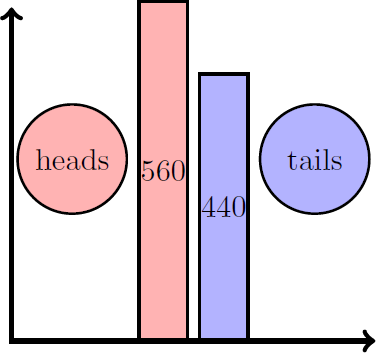Is the coin fair or unfair?

A coin is thrown 1000 times, resulting in 560 heads and 440 tails. The fact, that the result "heads" appears much more frequent, arouses the suspicion, that the coin is unfair and the two sides of the coin do not have the same probability . Is this suspicion justified, or is the bias for "heads" not significant?
This section requires Javascript.
You are seeing this because something didn't load right. We suggest you, (a) try
refreshing the page, (b) enabling javascript if it is disabled on your browser and,
finally, (c)
loading the
non-javascript version of this page
. We're sorry about the hassle.
We assume, that both sides of the coin appear with the same probability p = 1 − p = 2 1 . The probability P n ( k ) of having exactly k times tails (or heads) for an total number n = 1 0 0 0 of throws is given by a binomial distribution
P n ( k ) = ( k n ) p k ( 1 − p ) n − k = k ! ( n − k ) ! n ! 2 n 1
The mean value μ and the root mean square σ (RMS) results to μ σ = ⟨ k ⟩ = 2 1 n = 5 0 0 = ⟨ ( k − ⟨ k ⟩ ) 2 ⟩ = 2 1 n ≈ 1 5 . 8 The result k = 4 4 0 ≈ μ − 3 . 8 ⋅ σ is almost 4 standard deviations away from the mean value and therefore extremly unlikely. To be more precise, we calculate the probability P n ( k ≤ 4 4 0 ) , that k assumes a value in the interval [ 0 , 4 4 0 ] . We use the fact, that the discrete binomial distribution can be approximated by the continuous normal distribution with the same mean value and RMS for n ≫ 1 (central limit theorem)
P n ( k ≤ 4 4 0 ) = k = 0 ∑ 4 4 0 ( k n ) p k ( 1 − p ) n − k ≈ ∫ 0 4 4 0 2 π σ 1 exp ( − 2 σ 2 ( x − μ ) 2 ) d x = 2 1 [ 1 + erf ( 2 σ 4 4 0 − μ ) ] ≈ 7 ⋅ 1 0 − 5 = 0 . 0 0 7 % where erf ( x ) denotes the error function. Thus, such a significant difference between "heads" and "tails" occurs only in one out of every 14,000 cases for a fair coin. With a probability bordering to certainty, we can say, that this coin is unfair.